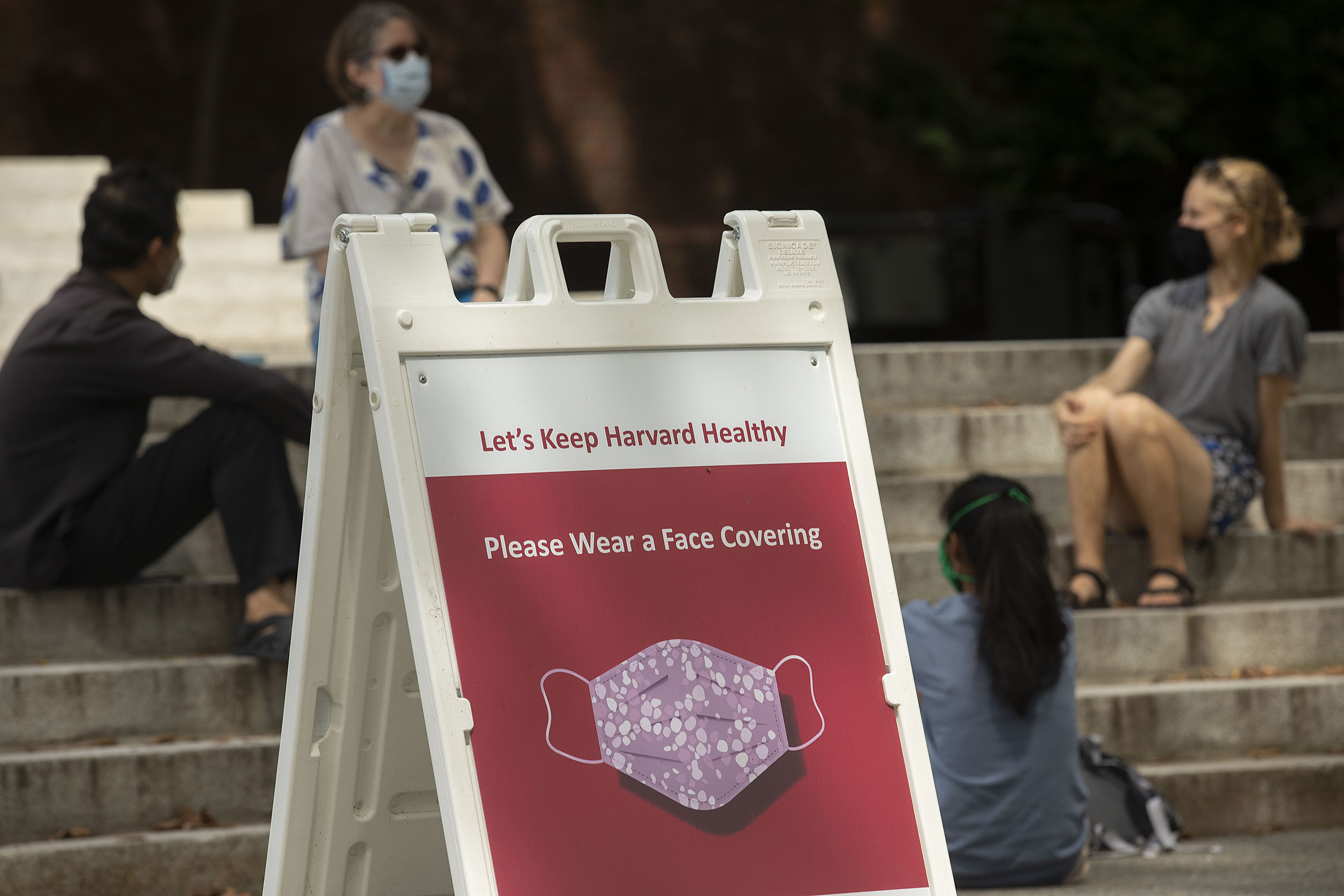
Harvard has several measures in place to reduce COVID-19 transmission rates.
Kris Snibbe/Harvard file photo
How Harvard’s multilayer strategy helps keep COVID rates low
Health Services chief points to air filtration systems, high vaccination rates, masking and testing protocols, and other measures
As the school year opens for students, faculty, and staff, the University has successfully employed a range of preventative measures to maintain a low rate of COVID-19 infection.
At Harvard, the positivity rate of all tests since the inception of the University’s COVID-19 testing program is 0.14 percent, and the rate for the past 7 days is 0.14 percent. Most of these transmissions have been traced to small and large social settings at which attendees removed masks to drink or eat indoors. To date the University has yet to identify a situation in which a community member was infected with the coronavirus due to a classroom exposure.
The Gazette spoke with Executive Director of Harvard University Health Services (HUHS) Giang Nguyen to learn more about how Harvard is keeping classrooms safe and for a reminder on how we can all do our part to help limit the spread of COVID-19 across the community. The interview was edited for clarity and length.
Q&A
Giang Nguyen
GAZETTE: Let’s start with a question that is on the minds of many members of the Harvard community. Is it safe for students, faculty, and staff to be in classrooms at Harvard?
NGUYEN: At Harvard, we have created an environment for teaching and learning that enhances the safety of everyone involved, thanks to a range of preventive measures. These include air filtration systems, a very high rate of community vaccination (94 to 96 percent), mandatory indoor mask use, and regular testing protocols. Acting together, these measures dramatically lower the risk of transmission within our campus community.
Moreover, HUHS has conducted in-depth interviews of everyone who has tested COVID positive in our program since the pandemic began, and we have yet to identify a situation in which a person was infected as a result of classroom exposure. And as long as we all continue to do our part, which the vast majority of our community are already doing, we can ensure that very little, if any, transmission takes place in the classroom.
GAZETTE: What about the fact that some students opted for a vaccine exemption? What if they are in a classroom at the same time as I am?
NGUYEN: When vaccination is not at 100 percent, it is possible to encounter unvaccinated persons on campus. Some people have submitted medical or religious exemptions, for example, but there are very few of these. If you happen to know that someone is unvaccinated, please make no assumptions as to why, and remember to model our shared values of kindness and mutual respect. Unvaccinated people are at greater risk of infection and severe illness than the vaccinated people around them.
Vaccination is arguably our most powerful weapon against the pandemic, but it is only one layer in our campus protection strategy. Universal masking is very effective in preventing infections — we saw this this before vaccines were available in hospitals where there are a lot more COVID-infected people than in our classrooms. Proper use of masks, coupled with robust measures to improve air quality, greatly reduces the risk of transmission, even if you are in the same classroom as someone who may be COVID positive.
Giang T. Nguyen answers frequently asked questions. Video by Kai-Jae Wang/Harvard University.
GAZETTE: You said the “proper use” of masks reduces risk. How do I properly wear a mask?
NGUYEN: The first step is to make sure that it is the right material: a disposable or tightly woven cloth mask with multiple layers. When worn, the mask should cover your nose and your mouth entirely, and it should loop over your chin. Make sure that it is secure to your face, which means that all of the edges including the top edge are free of air gaps, so that air only flows through the material, as opposed to around it. Make sure you do not have excessive slack in your mask when wearing it. If the mask is loose, it is more likely to have air gaps where respiratory droplets can get in. There are videos online that demonstrate ways to improve your mask fit. Double masking can also ensure a better fit: Wear a disposable mask next to your skin, then use a cloth mask on top to hold everything in place more securely and to reduce the chance of gaps.
Of course, it’s good to carry a mask with you at all times, even if you intend to be entirely outdoors, in case you need to step into a store or another indoor location unexpectedly, or in the event that you find yourself surrounded by a crowd outdoors.
GAZETTE: But how effective are masks when classrooms are at full capacity, and it’s impossible to properly physical distance?
NGUYEN: They are still very effective. While we advise instructors to maintain distance as much as possible, we know that it is not feasible for students, and sometimes professors, to be greater than 6 feet away from every person in the classroom. In most cases, you will be over 6 feet away from the majority of people in the room. It is possible that you will be less than 6 feet from a handful of people. But when everyone is properly masked, physical distancing is less critical than masking. Medical experts on our advisory group have emphasized this point, noting the experience within clinical settings throughout the pandemic.
It’s also important to remember that everyone who is in your classroom is part of a recurring COVID testing program. And anyone who does have an infection is identified quickly and placed into isolation to reduce risk for the rest of the community.
GAZETTE: What should community members know about the current testing protocols in place?
NGUYEN: The most important thing to remember is to stay engaged in regular testing — this is required of any community members who are on campus. Surveillance testing is important in tracking cases of COVID-19 on campus, and in particular it allows for early identification of infections, allowing us to take steps to reduce transmission with isolation and quarantine. Individuals can find their required testing cadence by logging onto Harvard’s Crimson Clear web app. In some situations, we might apply an adaptive testing approach in which members of a subset of the community are advised to test at a higher cadence than their customary frequency; this helps us to keep a closer eye on pockets of the campus community where we might be seeing a transient increase in cases.
And extra testing is absolutely allowed and encouraged if you have a known close exposure to an infected person or if you develop COVID-19 symptoms. It is also worth remembering that anyone who comes to campus is required to use Crimson Clear to report any new COVID symptoms, known exposures to an infected person, or any positive test that HUHS doesn’t already know about.
GAZETTE: But does testing really happen fast enough to do its job?
NGUYEN: Yes, it absolutely does. In general, we’re able to get results within 24 hours, which is highly effective. Demand for testing has increased substantially across the nation due to the surge of the Delta variant, and many Americans are waiting longer for test results. We are very fortunate to have ready access to testing here.
GAZETTE: If I receive a negative test result, can I socialize freely with other people who tested negative?
“It’s so important for all of us to remember that we are part of a shared community, and that it’s up to us to take care of each other, whether we’re in the classroom, or unwinding on the weekend.”
NGUYEN: That’s a great question. A negative test result does not bring your likelihood of infection to zero. It can take several days following an infection before you might test positive, which is why we are testing so frequently. In other words, a person could submit a negative test during their incubation period, and within a day or two they might become infectious. We test frequently to increase our chances of identifying infections early enough to prevent numerous exposure opportunities, but it is still important for everyone to minimize the number of close contacts in any given two-day window and wear a mask when socializing indoors or in tight crowds outdoors.
GAZETTE: What should I expect if I’m determined to be a close contact of someone with COVID-19?
NGUYEN: First off, take a deep breath. Being a close contact is not a guarantee that you will develop COVID-19. As a close contact, your risk of being infected is increased (we have seen some close contacts convert to infected cases), but if you are not feeling seriously ill, there is no need to panic. If you are fully vaccinated and have no symptoms, you may continue to go to work or class, but you should avoid social events and any activities that involve removing your mask around other people (and you should carefully monitor yourself for symptoms as well as frequently test for COVID). If you develop any symptoms (however mild) or if you are not vaccinated, you must stay home and await further guidance from HUHS. If you have no food at home and you are not in a setting where meal delivery has already been arranged, it is okay to get a grab-and-go meal as long as you are fully masked. Whatever your situation, it is important that you submit an extra COVID test soon after you learn that you are a close contact, and you should test frequently for the next week or so.
As a close contact, you’ll be included in Harvard’s confidential contact-tracing protocols, which are designed to limit the spread of the virus. Depending on the specific situation, you may be required to quarantine. You should follow whatever instructions are provided by the HUHS contact-tracing team. If you are uncertain whether HUHS knows that you are a close contact, you must submit your exposure status via Crimson Clear. And please be patient as you wait for outreach from HUHS. Our contact tracers must prioritize our communication with people who have officially tested positive before we reach out to close contacts. If there is a high number of new infections or many close contacts, the wait might be longer.
More like this
GAZETTE: And what if I do test positive?
NGUYEN: If you do test positive, we’ll ask you to move into isolation, usually for a period of 10 days (day zero is usually the date of the positive test or the first day of symptoms), and most people can resume normal activities on day 11. Some Schools will have separate isolation locations, while others will have you isolate in your current room. If you live off campus and receive a positive test result, you shouldn’t come to campus except to pick up test kits or drop off a test sample. Remember that test kits should be obtained from your School or Unit. Please don’t come to HUHS for your kits.
Of course, isolation and quarantine can be very difficult for anyone. For our students, it can be particularly taxing and emotionally difficult. HUHS and your School will provide resources to support you during these times, so that you can recover quickly if you’re sick, while staying as current as possible in your work. Please let your School and HUHS know if you have any unmet needs.
GAZETTE: Anything else you’d like to add?
NGUYEN: It’s so important for all of us to remember that we are part of a shared community, and that it’s up to us to take care of each other, whether we’re in the classroom, or unwinding on the weekend. The greatest risk of transmission that we’ve traced thus far is from small and large social settings that involve the removal of masks to drink or eat, especially indoors. In social settings, staying safe means keeping close contacts to a minimum, keeping your mask on, and planning outdoor events whenever possible.
We also have a shared responsibility to establish social norms that protect the most vulnerable among us. A mild infection in one person can potentially be passed along to another person who is elderly or immune-compromised. It is up to all of us to establish social expectations that include staying home when exhibiting symptoms, avoiding higher risk situations, and not pressuring others to participate in social events where unmasked indoor activity is anticipated.
Taking care of yourself and each other goes beyond COVID safety protocols, too. The pandemic has brought with it added stress and anxiety to so many people. Be kind and considerate with your fellow Harvard community members and reach out to a professional if you need help yourself. For mental health concerns, CAMHS Cares is available to students 24/7 at (617) 495-2042. The Employee Assistance Program is available to Harvard employees at (877) 327-4278.







